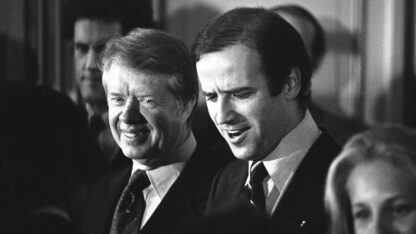More Than 100 Works Of Pablo Picasso And Alexander Calder Are On Display At The High Museum
Two titans of 20th century modern art, contemporaries in their own time, will reunite this summer: Pablo Picasso and Alexander Calder. The exhibition “Calder-Picasso” debuted at the Picasso Museum in Paris, and just moved to Atlanta’s High Museum of Art, to be on display through Sept. 19. Claudia Einecke, curator of European Art at the High, joined “City Lights” host Lois Reitzes to give a sense of what to expect at the exhibition, and why these two artists made an intriguing pair.
Interview highlights:
On the crossing paths of Calder and Picasso:
“They met for the first time in the early 1930s. Calder had moved to Paris not long before that, as a really emerging artist just starting out, whereas… Picasso was already quite established and well-known as the leader of the avant-garde in Paris,” said Einecke. “So certainly Calder would have been very aware of Picasso and his work, and his importance.”
“Calder attracted some… critical attention with early works he did in Paris, these wonderful, lively and dynamic wire figures,” continued Einecke. “He had an exhibition of some abstract work at a gallery in Paris, and Picasso heard about it and came to the opening… So in other words, he must have been intrigued enough by what he had heard and seen about this young American artist, to feel that it’s worth his while to check it out. So it was on that day that they met for the first time.”
A multifaceted, mixed media experience:
“There are these groupings where we really see some visual connections directly. So you have a Calder mobile, next to a Picasso painting, next to a Picasso sculpture, next to a Calder painting. So there’s this wonderful visual diversity and dynamic in the galleries that I think people will really enjoy,” said Einecke.
“[Calder’s early mobiles] tend to be smaller; simpler, in the sense that you just have several horizontals and from those, you would have objects or shapes hanging,” said Einecke. “And then the later ones, they become immensely complex…. The balancing act that they perform becomes much more complex. It’s really amazing to see, it’s like, ‘How did he come up with it?’”
Thematic interplay between the featured artists:
“The main theme in which their work is brought together in this exhibition, is different ways that each artist… worked with the absence of space. The void, the absence of mass, and yet, creating volume,” said Einecke. “There are some very exciting and interesting parallels and similarities. Although they are not necessarily inspired or influenced by the other, they both worked on the same artistic and aesthetic project and problems.”
“This exhibition is… not about one artist doing something, and the other one imitating, or being influenced or even inspired by it. It’s really more general to say you have two giants of modernism, and both of them in their work really defined and pushed forward what modernism is,” said Einecke.





